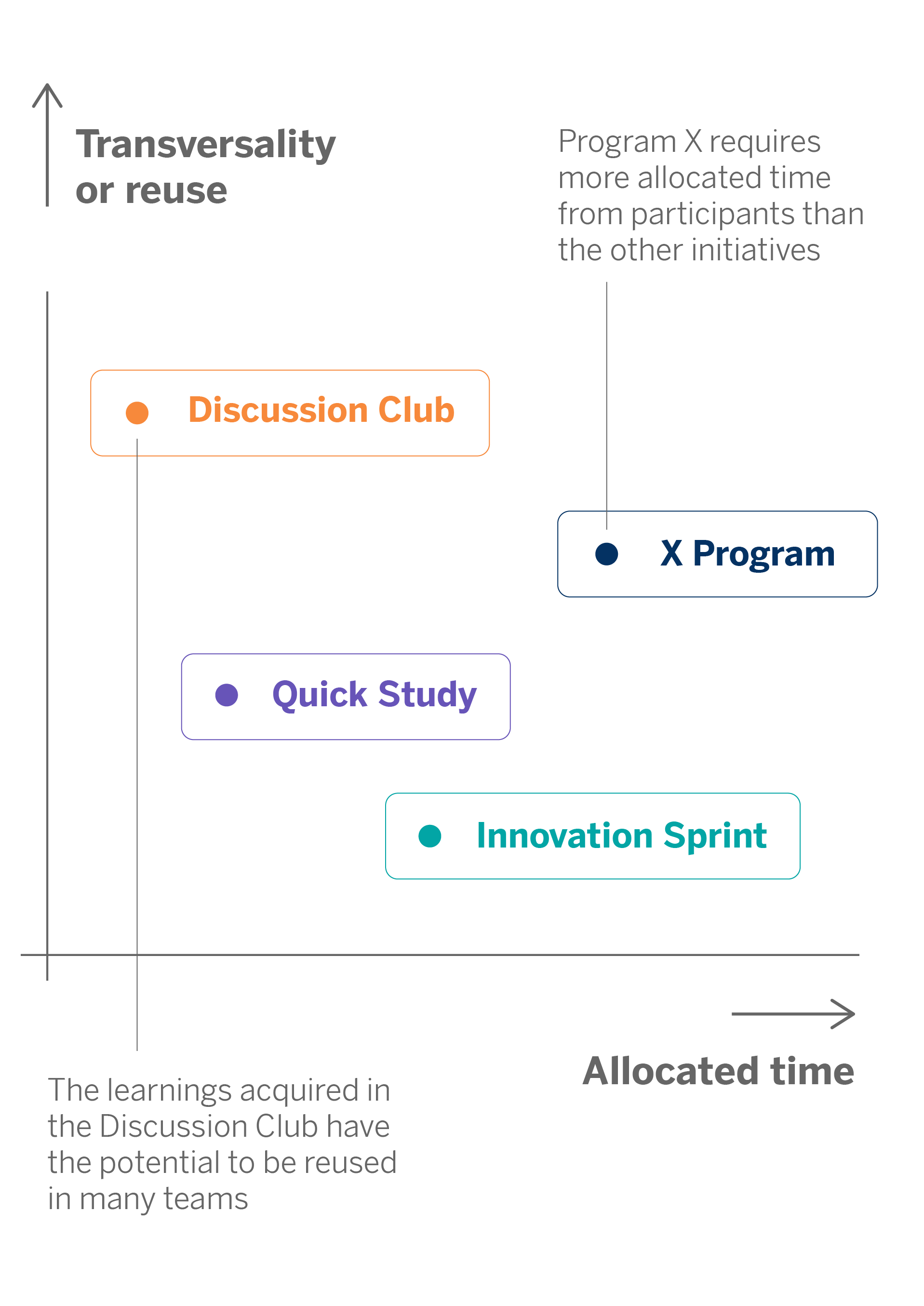
Four initiatives to drive innovation at AI Factory
Global Finance, a publication specializing in the financial sector, has included BBVA AI Factory for the second time in its list of the best financial innovation labs (2021 and 2023 editions). This recognition is in addition to the Best Workplace for Innovators award in the small companies category, which we received last year from Fast Company, a prestigious media brand focused on the intersection of business, innovation, and design. In their comprehensive list, we were ranked 40th in the world.
Under these recognitions lie our knowledge-sharing initiatives and innovation spaces, which are distinguishing aspects of our company. Participation in these initiatives has internally accelerated the development of cutting-edge solutions faster and more efficiently, as they facilitate a more transversal collaboration. This makes the boundaries between different work teams more porous.
At BBVA AI Factory, professionals with expertise in data science, solutions architecture, or engineering work closely with those responsible for the business and design of specific products. For example, they work together on the personalized alerts service of the BBVA app or the optimization of marketing campaigns. This approach enables us to combine diverse but essential profiles to create data-driven solutions, working more cohesively as a single team.
However, this work scheme requires the implementation of horizontal projects that facilitate communication, knowledge sharing, and reuse of analytical components between the technical profiles of different teams. BBVA AI Factory’s data science discipline has been promoting several programs in this regard for some years, highlighting four main initiatives: Discussion Club, Quick Studies, Innovation Sprints, and X Program.
The differences between these initiatives are determined by their level of transversality or independence concerning the product teams and the amount of time required of the participants.


Discussion Club
Level of transversality: highTime required: low
Level of transversality: high
Time required: low
The Discussion Club is a one-hour forum open to anyone at AI Factory, held every two weeks. Here, we share technical challenges, ask for feedback, and discuss different points of view when approaching a project. There is also time to present side projects related to the world of data, whether completed in the past or pursued as a hobby, as well as hot topics we have read about or seen at conferences.
Through the Discussion Club, we have discovered a valuable tool to keep up to date with what is happening in the rest of the teams and learn about new approaches or techniques useful in our daily work. Ultimately, it is a suitable environment for inspiration and innovation to be the protagonists.
For instance, a few weeks ago, our colleague Álvaro Ibraín gave us an in-depth talk about diffusion models and how they are used in the industry to generate images and visual content given a prompt.

Quick Study
Level of transversality: mediumTime required: medium
Level of transversality: medium
Time required: medium
A Quick Study involves a small theoretical investigation into a new technique that could be applied to solve a problem or challenge and can be shared among teams. Anyone interested in the issue can participate, whether it affects their team or motivates them to learn more about the topic.
This small study aims to obtain a more or less holistic conclusion and share the knowledge acquired with colleagues using internal dynamics, such as the Discussion Club. In other words, the result is knowledge made available to others.
A group of colleagues identified the need to investigate the best way to evaluate multilabel and multiclass models (with dozens of classes) for different use cases to compile the state-of-the-art and make a proposal. As a result, a Quick Study was carried out.
X Program
Level of transversality: highTime required: high
Level of transversality: high
Time required: high
This initiative aims to convert ideas into functional prototypes that offer solutions to shared challenges, and will be used by different teams. The goal is to create a new workspace where the objective is to experiment, implement and test the initial phases of a novel product idea from the data, thus following the philosophy of “validate an idea by starting to make it”1.
One of the main features of Program X is the configuration of temporary teams comprising three or four data scientists working in different groups to develop the idea over two or three months. The team is disbanded once the prototype is presented, and the idea-gathering phase begins again. Additionally, the idea or innovation opportunity cannot be part of the backlog of ongoing projects but may impact them.
Annotify is a clear example of a prototype created in Program X. The project involved developing a fast data labeling system using a statistical technique called active learning2.
Innovation Sprint
Level of transversality: lowTime required: medium
Level of transversality: low
Time required: medium
At BBVA AI Factory, we set aside specific blocks of time to experiment with state-of-the-art technology. This allows us to work on ideas that could be further developed and included in BBVA’s Artificial Intelligence-based solutions. We call these blocks of work Innovation Sprints, which serve as the seed of X Program.
These innovation spaces last two weeks, following the agile methodology’s sprint duration. Unlike X Program, only members of one team participate, and they research and explore possible solutions to a specific challenge for their product. In contrast to X Program, developing a functional prototype is not required in this case.
One of our lines of work involves optimizing and improving BBVA’s relationship model through data-driven solutions. In one of our Innovation Sprints, the corresponding team experimented with language models to build a system that helps BBVA managers in written communication with customers.
Notes
- This vision is related to the concept of discovery-driven prototyping and evokes early approaches to data science, in which data scientists themselves proactively explore new product features rapidly. ↩︎
- Active Learning is an automatic technique that allows the person tagging data to know which items have the most valuable tags. ↩︎